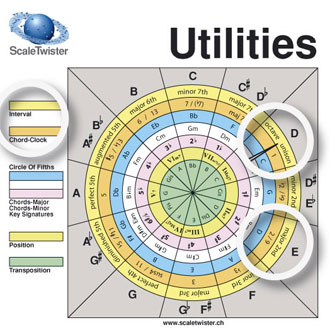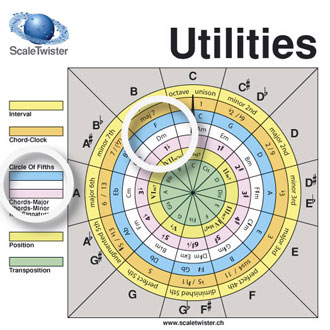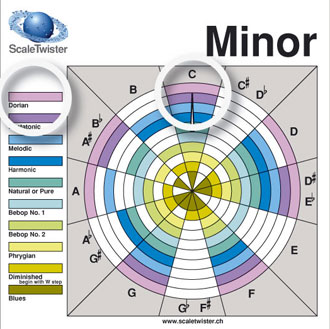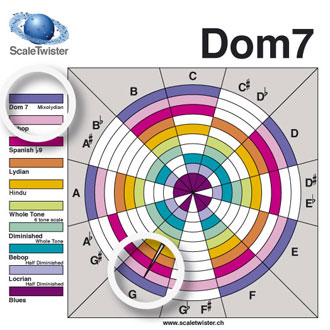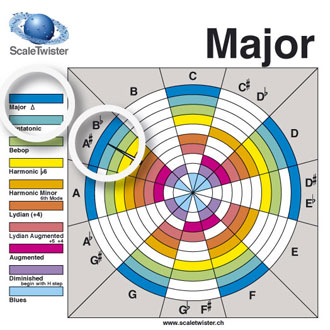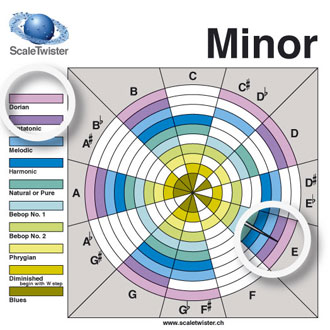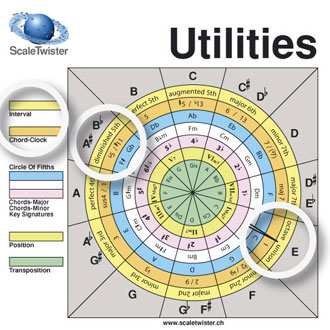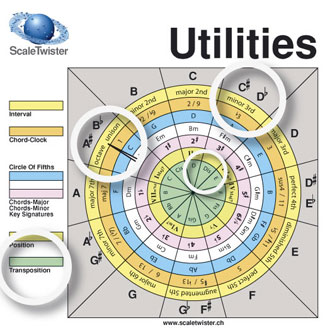Example
An example step by stepHow Insensitive - With help of this beatiful song from Antonio Carlos Jobim we will demonstrate to you step by step how you can utilize the ScaleTwister..
improvisation example
How Insensitive
In the 1st and 2nd measure: We are looking for Dm9 and use the minor ScaleTwister.
In the first step we are looking for Dm..
In the legend on the left we have the purple color for the Dorian scale. We are rotating the wheel such as the pointer points to D. The purple color fields show us the notes that fit with the Dm chord.
D E F G A B C.
Look for your personal sound, experiment with other minor scales. Pentatonic fits well too. Try to feel the different colorings for melodic, harmonic or natural minor scale.
ScaleTwister shows us what notes do not fit with DM (white fields): Eb Gb and Ab
In the 1st and 2nd measure, what degree is Dm? Utilities give us the answer.
On left hand side the legend shows the light green as „Position“ (degrees). No signs mean C major; so we point the pointer to C and hereby we can read the degree from the light green color. Dm is the 2nd degree in C major.
The blues progression always goes thru the degrees I, IV and V. With this tool we can easily find the degrees in all keys.
For example a blues in D has the degrees of D, G and A.
In the 1st and 2nd measure, what does the 9 mean inm9 chord? Here too the utilities have the answer.
We find in the legend the orange color „Chord-Clock“ and turn the wheel to position D.
On the orange circle the chord tensions are indicated with numbers. We are looking for 9 and can read the note E on the grey background.
There is also the note E as a tension in chord Dm9 that makes the characteristic of this chord. Play this note when you improvise, it adds color!
In the 1st and 2nd measure, minor scales can be substituted!
A minor scale can be substituted with a parallel major scale.
In the legend we can find the colors of the circle of fifth; blue, white, and pink.
F is the parallel key of Dm
Alright, let’s play F major over the Dm chord, this sounds really good! Don’t forget the pink color! F major and D minor have the same key signature.
Now, everything makes sense!
Substitution is the magic word.
In the 3rd and 4th measure, diminished chords we find on the Minor ScaleTwister.
In the legend we can read „Diminished begin with W step“.
We turn the wheel to the key of C# and find the ocher color fields for the notes C#, D#, E, F#, G, A, and Bb.
And we play C# diminished!
In the 5th and 6th measure, C minor 6
- Cm:
Minor ScaleTwister, Dorian, point pointer tof C – C, D, Eb, F, G, A und Bb - 6:
Utilities turn pointer to C, Chord-Clock, the chord extension 6 corresponds to the note A.
Jazz musicians often use the melodic minor scale. It fits to most minor chords.
Minor ScaleTwister, Melodic, pointer to C.
C D Eb F G A B
In the 7th and 8th measure, G7/B — we use the Dom7 ScaleTwister
- G7:
Dom7 ScaleTwister, Mixolydian, the Pointer to G.
G A B C D E F. - B:
B after the forward slash means the bass has to play the note B.
G mixolydian?
Let’s take the Major ScaleTwister, set the pointer to C and compare the two scales, C major and G7 are the same! - G mixolydian?
Let’s take the Major ScaleTwister, set the pointer to C and compare the two scales, C major and G7 are the same!
More information about this with the modes of the major scale. Modi der Major-Scala.
In the 9th and 10th measure, Bmaj7
- Bbmaj:
ScaleTwister Majorset pointer to Bb
Bb C D Eb F G A.
More information about chords Akkorden
In the 11th and 12th measure, Ebmaj7
- Ebmaj:
ScaleTwister Majorset pointer to Eb
Eb F G Ab Bb C D.
More information about chords Akkorden
In the 13th measure, Ebm7 b5
- Em7b5:
Minor ScaleTwisterset pointer to E.
E Gb G A B Db D.
More information about chords Akkorden
In the 13th measure, Ebm7 b5 — we use the Utilities wheel again
- b5:
Utilities, Chord-Clockset the pointer to E, at orange b5 is the note Bb.
The minor b5 and the diminished chords in the same key contain the same notes.
We also have an alternative here; to play over a chord a different scale or vice versa to choose a different chord for the accompaniment.For m7b5 the locrian half diminished scale fits too.
Transpose
So far so good. But you play an instrument that is not tuned to C. For example a tenor saxophone. Here too the ScaleTwister can help you. Put the pointer to the key of our instrument, for our example, the tenor saxophone, to Bb. Then you choose on the grey background the key that you need to transpose to, e. g. C#.
Transpose is the green color on the wheel. We can find then on the green field the transposed note D#.
That’s it …
Alright you got it …
For each topic you will find a link in the glossary for the explanations. You can also use the search field to find an explanation. Use the website for a better understanding and for more information.
If you have questions or comments feel free to send us an email. (the email links are located at the bottom on each site). We appreciate your feedback.
…. caution, ScaleTwister is not the whole truth!
Ear training is important.
Robert Ruegg, music instructor at the Swiss Jazz School in Bern, Switzerland, tested the ScaleTwister and recommends it. He also reminded us that we need to emphasize on our website that ear training needs to go hand in hand with the ScaleTwister.
There is no topic that is more important to a musician and at the same time causes frustration, anger, insecurity, even fear.
Why? The answer is simple; every musician knows that without a good ear he has no chance.
Hearing and knowledge should ideally develop in synchronicity. But the fact is that the hearing almost always lags the knowledge.
The ear is the door to music, the interface between the inner imaginary world and the reality of the sound. For the musician the hearing is the most important sense, his antenna, the link between ideas and his fingers.
The one that only knows theoretically scales and chords is not a good and convincing musician. The saying „One can know everything but doesn’t understand anything“ hits this to the point.
Music can live perfectly without theory, but theory can not exist without music.
Use the many advantages that the ScaleTwister offers, but don’t forget the ear training!
and here is a little video tutorial



